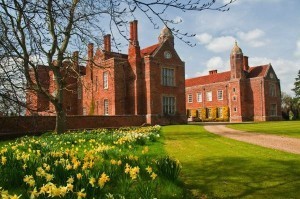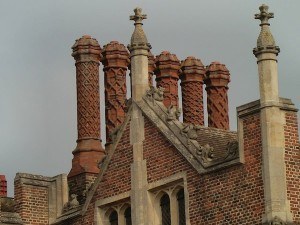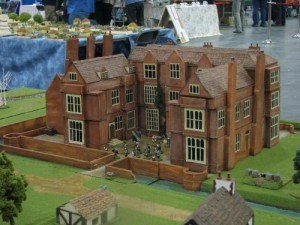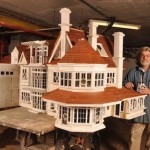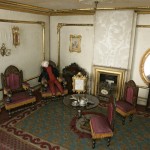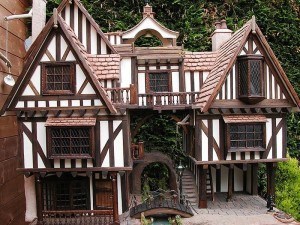
Tudor Half Timber Dollhouse -“A River Runs Through It” is the caption on Gerry Welch Manorcraft Dolls Houses
The Tudor Period (1485-1603)
When thinking about Tudor home exteriors, keep in mind that Tudor architecture is an outgrowth of Medieval design, where the nobility and upper classes lived in fortified castles: crenelated battlements and moats. They were huge uncomfortable places in which to live. Peace settled on the land with the end of the Wars of the Roses in 1485. The Tudors came to power and castles became passé; the aristocracy “downsized” to manor houses. Even though many were as large as the fortresses they replaced, the manor house was built to comfort the gentry, not repel invaders.
Building Materials
The floor plans of these residences were usually E or H-shaped. Stone was a plentiful building material after the Dissolution (1536-1540) when Henry VIII had over 900 cathedrals and monasteries demolished. Brick became popular but was expensive. The half-timber construction we identify as ”Tudor” today was used as an accent on some manor house. Its primary use was mainly in the homes of commoners.
Tudor Manor Houses
Because of their size, Tudor Manor dollhouses are not too popular with most miniaturists. That’s not true with room boxes, of course. I’ll leave that for an article on Tudor Interiors. Still, it’s good to have some idea of the main architectural features of the stately manors of England. Here are some principal features:
Gables, lots of gables, unavoidable with the E or H floor plan. Roofs were sheathed in slate or tile.
Arches remained popular. Not the peaked gothic arch, but a flattened version with a wider base.
Oriel windows, a form of bay window, jutted from upper floors supported by corbel brackets.
Fireplace design improved, which allowed them to be placed in any room. Consequently, chimney stacks sprouted on the rooftops.
Gardens. Geometric landscaping was popular in the back of the home. The space between the wings of the houses provided enclosed courtyards.
Large displays of glass in very large frames, several feet long. Panes were small, usually diamond shape, with beads of lead holding them together. Glass was expensive so only the rich could afford numerous, large windows.
Tudor Commoner Houses
The houses and buildings of ordinary people were typically built with the method called Timber Frame with Wattle and Daub. It is a simple construction method that lasts for centuries.
The Frame
Drive hand-hewed posts, preferably oak, into the ground or anchor them to a foundation or footing. Cut notches in the top of each post and lay a beam on top of the posts with both ends notched to fit into the notched posts. Drill a hole through the join and drive a wooden peg into it. Cross brace it the same way.
The Wattle
Weave a lattice of wooden strips, the size and shape of the openings between the timbers, daub it with a sticky substance made of wet soil, clay, sand, animal dung and straw. Paint white and let dry. When attached to the building, half of the timber is exposed. Hence the term “half-timber” construction. This method could be adapted to any size dwelling.
Other features
Floor plans of Commoner’s homes in cities and market towns tended to be square or rectangular to match typical lots in crowded areas.
Farmhouses retain a small fat ‘H’ shape and traces of late Medieval architecture. Modification was less expensive than entirely rebuilding.
Steeply pitched thatched roofs were most common, but the better-off Commoners might use tiles or clay slates. Miniaturists, please note: London banned thatched roofs within the city after the Great Fire of 1666.
Tall, narrow doors, windows too. They had small diamond-shaped window panes, typically with lead casings to hold them together
Dormer windows, late in the Tudor period.
The half-timber dollhouse at the top of this article is a treasure. The caption on Gary Welch’s website is “A River Runs Through It.” It’s not a river, really, but what a clever idea. The model of Kentwell Hall links good photos of its foam core construction.
Click on the photos for links to all websites.
Susan Downing, with Patrick Owens


